Hoi An World Cultural Heritage Conservation Center
INTANGIBLE CULTURAL HERITAGE
Visitors will be attracted by spiritual cultural value and intangible cultural forms that has existed for ages through the generations on the Cham Islands. The intangible culture includes the phonetic system, traditional vocabulary, and proverbs and folk-speech. These feature the characteristics of the Cham Islands, social experiences, work, and the local people’s feelings. Traditional legends and interesting folk stories tell us of the origin of the islands; natural disasters, typhoons and places of interest including streams, islands, and waterfalls. They also tell of the origin of salangane’s nests; and of folk-songs including “Hát Ru, Hát Hò Khoan, Điệu Hò, Lý, Hát Bả Trạo, Múa Đèn” related to the marine lives on the islands. In addition, the festivals and folk games express the diversity of the cultural origins and religion, traditional thought, indigenous life, culinary art, and humanitarian features. Generally speaking, it is the way of the communities to adapt to the natural and social environment to maintain and develop them. It is the intangible culture that features the uniqueness of the culture of the Cham Islands, and the diversity of the Hoi An culture heritage, Quang Nam in particular and the national culture in general.
1/ THE BIRD NEST GATHERERS ANCESTRAL SACRIFICE FEAST ON THE CHAM ISLANDS
The bird nest gatherers ancestral sacrifice Feast on the Cham Islands is one of the big festivals of the Cham Islands in particular and Hoi An in general. It is also the festival of praying of peace at the beginning of the year for resident community living on the island. The sacrifice feast often takes place for two days. At night of the first day (on the 9th of the 3rd lunar month), the oldest persons and representative of families relating the bird nest gatherers concentrate at ancestral temple to celebrate “lễ túc”. According to the conception of the oldest persons, “lễ túc” informs ancestor, gods with the main sacrifice tomorrow. In the morning of the 10th of 3rd lunar month, with prepared boat teams, the priest and the local people celebrate the “nghinh thần”, “rước vọng” ceremony. The “nghinh thần” procession passes across the temple areas along Bai Huong beach to Bai Lang, Bai Ong. When “nghinh thần” procession comes back, the altar is put in the garden of temple for worshiping the spirit and ancestral sacrifice feast. Ancestral sacrifice feast praises the merit of the founders, the protecting gods to pray career development and peace for everyone. After the ancestral sacrifice feast, there are some extra sport activities such as: tug of war, basket boat shaking, boat race,…
The bird nest gatherers ancestral sacrifice Feast on the Cham Islands is one of the big festivals of the Cham Islands in particular and Hoi An in general. It is also the festival of praying of peace at the beginning of the year for resident community living on the island. The sacrifice feast often takes place for two days. At night of the first day (on the 9th of the 3rd lunar month), the oldest persons and representative of families relating the bird nest gatherers concentrate at ancestral temple to celebrate “lễ túc”. According to the conception of the oldest persons, “lễ túc” informs ancestor, gods with the main sacrifice tomorrow. In the morning of the 10th of 3rd lunar month, with prepared boat teams, the priest and the local people celebrate the “nghinh thần”, “rước vọng” ceremony. The “nghinh thần” procession passes across the temple areas along Bai Huong beach to Bai Lang, Bai Ong. When “nghinh thần” procession comes back, the altar is put in the garden of temple for worshiping the spirit and ancestral sacrifice feast. Ancestral sacrifice feast praises the merit of the founders, the protecting gods to pray career development and peace for everyone. After the ancestral sacrifice feast, there are some extra sport activities such as: tug of war, basket boat shaking, boat race,…
2/ THE FISHING FESTIVAL ON THE CHAM ISLANDS
Ca Ong worship (Whale worship) is the custom of almost fishermen in Vietnam Central Coast from the ancient time to now. The places where fishermen live have the Ong temple to worship Ca Ong. According to the conception of fishermen, Ca Ong is the Sea God who often helps the victims on the sea. So, when Ca Ong died and drifted on shore, the local people have to do the funeral following “Thọ mai gia lễ” book, then inhume and bring its bone in the temple to worship. The former Vietnam Feudal Court also recognized the important role of Ca Ong and conferred fine names “Nam Hải Cự Tộc Ngọc Lân tôn thần”, fishermen in everywhere built the temple to worship.
On Cham Islands, when fishermen detect Ca Ong died, they often inhume at Bai Ong Hamlet, because this beach has a low slope and wide land. This is an advantage for burial. After three years, the local people dig to take Ca Ong’s bone, clean it by alcohol and pick up to The Ong temple in Bai Lang.
Every year, before pushing off and going fishing, fishermen of the Cham Islands often celebrate a sacrifice ceremony named the fishing festival at the Ong temple. This festival has a quite large scale and attracts the participation of almost fishermen on the island and the surroundings.
The fishing festival resembles the traditional rituals over many generations in locality. The sacrifice feast takes place for two days. Main participants are the oldest persons, the local people and the surrounding fishermen. After the sacrifice feast, there are some sport activities such as: boat race, basket boat shaking, tug of war,…
Ca Ong worship (Whale worship) is the custom of almost fishermen in Vietnam Central Coast from the ancient time to now. The places where fishermen live have the Ong temple to worship Ca Ong. According to the conception of fishermen, Ca Ong is the Sea God who often helps the victims on the sea. So, when Ca Ong died and drifted on shore, the local people have to do the funeral following “Thọ mai gia lễ” book, then inhume and bring its bone in the temple to worship. The former Vietnam Feudal Court also recognized the important role of Ca Ong and conferred fine names “Nam Hải Cự Tộc Ngọc Lân tôn thần”, fishermen in everywhere built the temple to worship.
On Cham Islands, when fishermen detect Ca Ong died, they often inhume at Bai Ong Hamlet, because this beach has a low slope and wide land. This is an advantage for burial. After three years, the local people dig to take Ca Ong’s bone, clean it by alcohol and pick up to The Ong temple in Bai Lang.
Every year, before pushing off and going fishing, fishermen of the Cham Islands often celebrate a sacrifice ceremony named the fishing festival at the Ong temple. This festival has a quite large scale and attracts the participation of almost fishermen on the island and the surroundings.
The fishing festival resembles the traditional rituals over many generations in locality. The sacrifice feast takes place for two days. Main participants are the oldest persons, the local people and the surrounding fishermen. After the sacrifice feast, there are some sport activities such as: boat race, basket boat shaking, tug of war,…

Source: Hoi An Center for Cultural Heritage Management and Preservation










